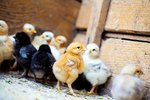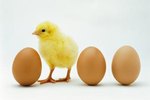If you’re a backyard chicken or turkey farmer whose hens are not producing chicks, artificial insemination with a proven rooster or tom can save your operation. According to the Food and Agricultural Organization of the United Nations, “If done properly, the level of fertility can be as high or higher than those obtained with natural mating.” Insemination takes time and labor, and you may need several attempts before the procedure works for you.
Semen Collection
The techniques of artificial insemination (AI) actually begin prior to the procedure. Housing the male poultry away from the hens maximizes the amount of available semen. Because the bird’s penis is located in the same duct as his anus, removing food 12 hours prior to collection will help prevent fecal contamination of the semen. Roosters and tom turkeys need to be routinely primed for semen collection for several days prior to the actual AI procedure to guarantee each bird is fertile with a microscopic examination of the sperm.
As with semen collection of other farm animals, you must stimulate your bird’s copulatory (sexual) organ to extend outside of his body. One person can handle this procedure with small birds such as chickens or quail; it normally takes two people with a large turkey or goose.
Begin by upending your male, and, holding his head under one arm and supporting his body on your lap, grasp his legs in one hand and his tail in the other. Start firmly stroking down the middle of his back to the end of his tail with one hand. With the other hand (usually the one holding the legs), use two fingers to massage his vent. The vent is the area between the bird’s abdomen and his tail. Once the bird is comfortable and relaxed, begin massaging the pubic bone between his legs. His penis will become erect and extrude outside of his body. As semen flows from the phallus in a fertile bird, you can collect it with an aspirator or any small tube.
Hen Insemination
Because poultry semen loses viability within 1 hour, hen insemination should begin immediately after collection. You begin by holding the hen upside down against your body in the same way you held the rooster or tom. Exerting firm pressure on the left side of the vent causes the cloaca (the uro-genital opening in birds) to evert; you need to use your thumb and forefinger to expose the oviduct (vagina). The oviduct is the opening on the left side of the cloaca next to the anus. You can insert the insemination tube as far as possible up the oviduct, then squeeze out the semen and release the pressure on the cloaca at the same time. Relaxing the cloaca draws the semen further into the hen’s body.
For maximum fertility during breeding/laying season, turkey hens can be inseminated every 10 to 14 days because of the tom’s highly concentrated semen, according to the Merck Veterinary Manual. Chicken inseminations can be completed on two consecutive days and then once a week after that. Because most hens will carry an egg in their oviducts in the morning, thus obstructing the route of the sperm to the ovary, insemination should occur in the afternoons after laying.
References
- Food and Agricultural Organization of the United Nations: Artificial Insemination
- The Merck Veterinary Manual: "Artificial Insemination"
- "A Technician's Guide to Exotic Animal Care"; T. N. Tully, DVM, M. A. Mitchell, DVM; 2001
Photo Credits
-
the hen on freedom image by Yuriy Poznukhov from Fotolia.com




